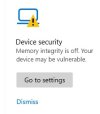A few more details/updates:
The complaint I'm getting from Windows Security on both this laptop and the other one I upgraded from 10 to 11 (both with AMD APUs, but of different generations) is this:

I'm just dismissing it since it appears that neither one of these APUs supports virtualization in a way that Windows needs it to be for this function to work. Didn't have it under Win10, so not a big deal.
Here's a shot of the "What to keep" dialog when I was installing Windows 11 on the first machine, where I did NOT have the registry hack in place but was using a Rufus created bootable drive (and running directly from it, firing it off under Windows 10):

On this machine, where I did do that registry hack, I got a dialog that I had not received on the machine that didn't have it that warned me that this was hardware that was not fully compliant with Windows 11 minimum specs and trying to ward me off of upgrading. I suspect that since Microsoft is the one that distributed that registry hack this is a built-in feature during Windows 11 install triggered from within Windows 10 if that key is present.
Today I had my first issue with Windows 11, but since it occurred after I was making some changes with WinAero Tweaker I can't say whether or not that might have been a factor. That being said, web searching shows that others have encountered it, too. The search button stopped working and so did the Windows Key (virtual and physical). If the search button was activated the search window would pop up, but with nothing on it, and you could not type in the search box. It would then keep disappearing and reappearing sometimes with a solid background and sometimes transparent, but you could never interact with it. Hitting the Windows Key and immediately typing a search wouldn't work, either. I tried a
DISM /Online /Cleanup-Image /RestoreHealth, which found no issues and did not fix the problem. One web solution on
this answers.microsoft.com page suggested following up with running,
DISM /Online /Cleanup-Image /startcomponentcleanup. This did remedy the problem.
I decided to run an
SFC /SCANNOW afterward, just for good measure, and it's been runnig for several hours now. I've never had SFC proceed quite this slowly, but it's still showing increasing percentages, at a glacial pace, so I'm going to let it finish. I don't expect it will find anything, though.


